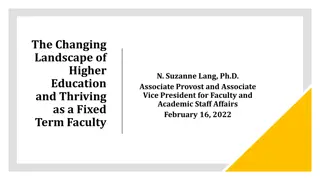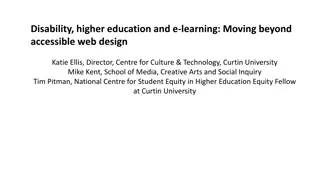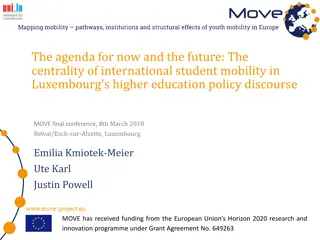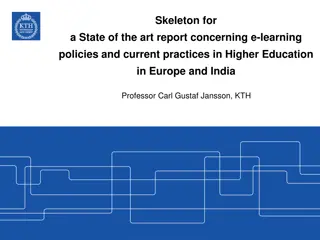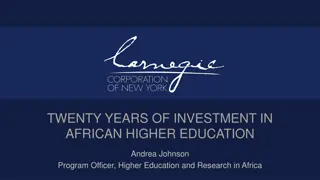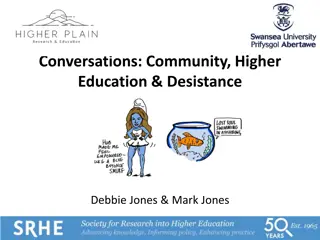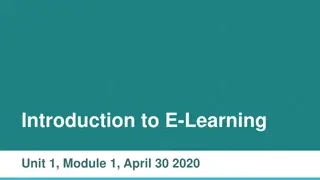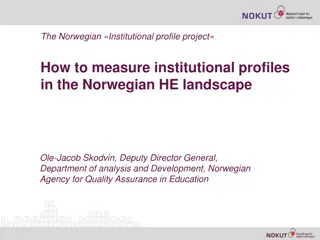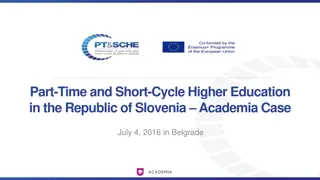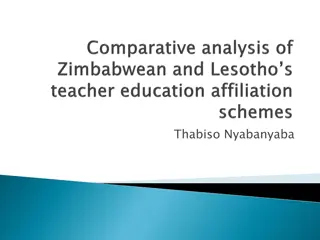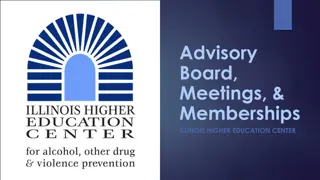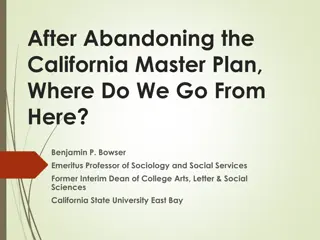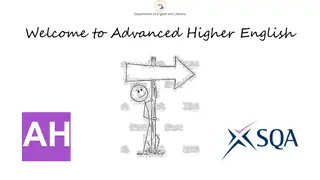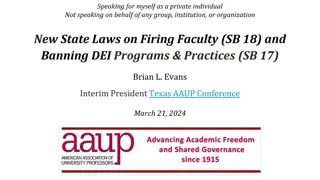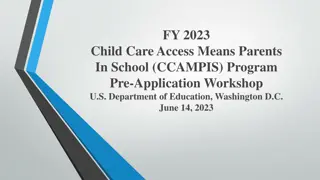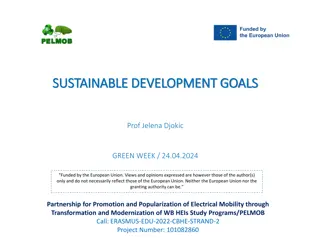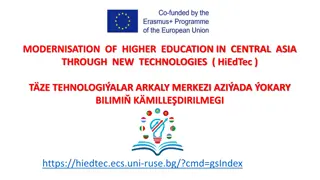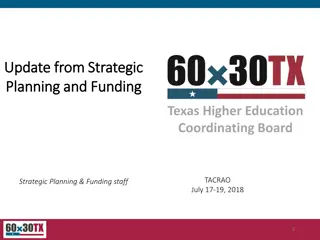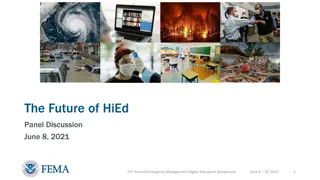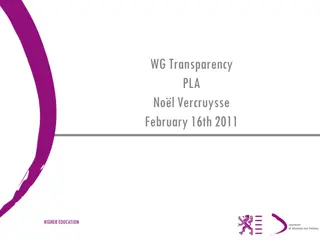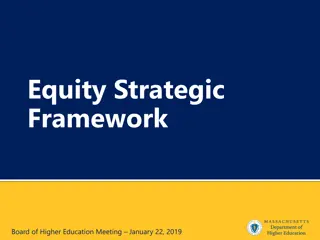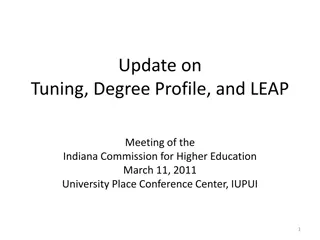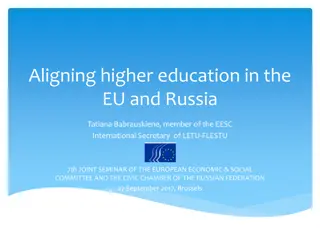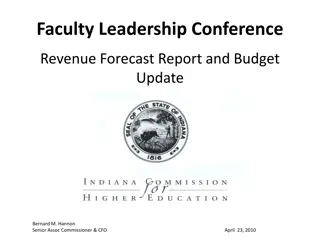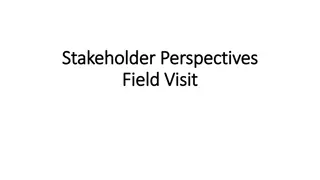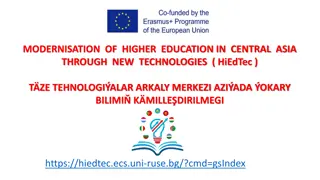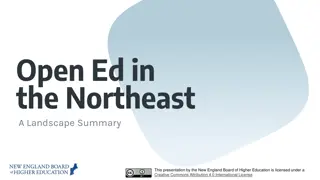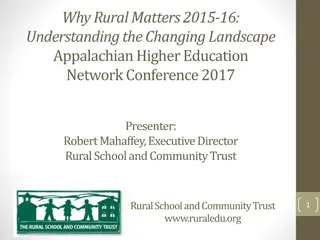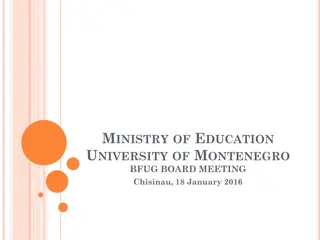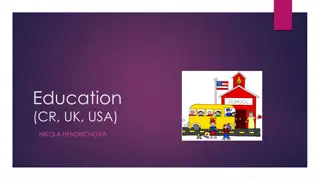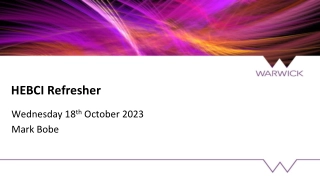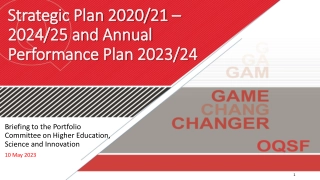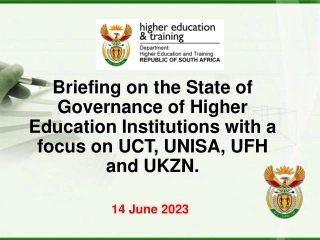Trends in Higher Education Landscape
The evolving landscape of higher education in the United States is depicted through data on investment in postsecondary education, distribution of enrollments, enrollment trends by gender and post-graduation paths, and employment ratios based on educational attainment levels from 1972 to 2014.
Download Presentation

Please find below an Image/Link to download the presentation.
The content on the website is provided AS IS for your information and personal use only. It may not be sold, licensed, or shared on other websites without obtaining consent from the author. Download presentation by click this link. If you encounter any issues during the download, it is possible that the publisher has removed the file from their server.
E N D
Presentation Transcript
The Changing Landscape of Higher Education* October 2015 D. Merrill Ewert, Ph.D. Patricia A. Anderson, Ph.D. * An expanded version of this presentation was given at a symposium on the future of Mennonite Education, at Bluffton University on October 18, 2015.
Higher Education in the United States
Annual investment [in billions] in formal and informal, postsecondary workforce education & training in the U.S. (in 2013 dollars) $18 [Total: $885 billion] $47 $60 Employer-provided informal training 4-Year Colleges $413 2-Year Colleges Certificates, Apprenticeships, other workforce training Federal Training $347 Source: Georgetown University Center on Education & the Workforce, College is Just the Beginning, Figure 1, Feb, 2015.
Distribution of all enrollments in degree-granting, Title IV-eligible institutions: 2013 1,656,227 8.1% Public 3,974,004 19.5% Private non-profit Private for-profit 72.4% 14,745,558 Source: National Center for Educational Statistics, Digest of Statistics, Table 303.5, July 2015.
Percentage of 18 to 24-year old men and women enrolled in degree-granting institutions: 1972 - 2012 Men Women 50% 44.4% 39.7% 40% 36% 37.6% 30.2% 33.7% 32.7% 27.2% 30% 26% 20% 21.2% 10% 0% 1972 1982 1992 2002 2012 Source: National Center for Educational Statistics, Fast Facts; Table 302.60.
Percent of high school graduates going directly to college (2 and 4-year institutions): 1975-2013 Total 2-year 4-Year 80% 68.6% 65.9% 68.1% 70% 63.3% 61.9% 60.1% 57.7% 60% 50.7% 49.3% 50% 44.6% 41.9% 42.1% 41.4% 40.4% 40% 38.1% 40% 32.6% 29.9% 30% 26.7% 20% 24% 23.8% 21.4% 21.5% 20.1% 19.6% 19.4% 18.2% 10% 0% 1975 1980 1985 1990 1995 2000 2005 2010 2013 Source: National Center for Educational Statistics, Digest of Educational Statistics, Table 302.10.
Employment to population ratios of persons 16 to 64 years old, by age group and highest level of educational attainment: Selected years, 1975 through 2014 Less than H.S; no degree Some College: No degree H.S. Diploma Bachelors or higher 100% 80% 60% 40% 1975 1980 1985 1990 1995 2000 2005 2010 2014 Source: National Center for Educational Statistics, Digest of Educational Statistics, Table 501.50, September 2015
Some challenges facing independent colleges and universities 1. Rising cost of college 2. Low graduation and retention rates 3. Geography and demography 4. Disconnect: what students & employers want 5. Institutional vulnerability/sustainability 6. Rising Discount rate 7. Underprepared students 8. Student debt 9. An uneven playing field
Average total tuition, fees, room and board rates charged for full- time undergraduate students in degree-granting institutions: 1982 83 to 2012 13 Four-year Public Four-year private (In Constant 2012-13 dollars) $40,000 $35,074 $33,032 $30,220 $30,000 $24,634 $20,000 $17,474 $16,797 $14,503 $12,434 $9,772 $10,000 $7,534 $0 1982-83 1992-92 2002-03 2007-08 2012-13 SOURCE: U.S. Department of Education, National Center for Education Statistics. (2015). Digest of Education Statistics, 2013 (NCES 2015-011).
2. Low Graduation and Retention Rates
6-Year graduation rates: entering school, 1996-2007 For-Profit Public Non-Profit 70% 60% 50% 40% 30% 20% 1996 1997 1998 1999 2000 2001 2002 2003 2004 2005 2006 2007 Source: National Center for Educational Statistics, IPEDS Trend Generator, 2015.
Profile of U.S. Freshmen, Fall 2014: distance from home to the college they attended 5.4% 5 miles or less 16.3% 7.2% 6-10 miles 11-50 Miles 51-100 miles 28.4% 26.6% 101-500 miles 16.1% Over 500 miles Source: The Chronicle of Higher Education: Almanac of Higher Education 2015-16; Vol. LXI, No. 43, p. 32, Aug, 21, 2015.
Distribution of public undergraduate enrollments by type of institution in selected states, 2010 Research Masters Bachelors Community College Other 100% 1% 1% 1% 1% 2% 4% 35% 80% 45% 48% 42% 49% 70% 3% 60% 17% 5% 2% 3% 3% 17% 13% 40% 18% 1% 47% 45% 20% 17% 38% 37% 29% 11% 0% USA California Indiana Kansas Ohio Virginia Source: Delta Cost Project at American Institutes for Research, www.deltacostproject.org.
Total number of students enrolled in postsecondary institutions in selected states, 2010 Total number of students Percent attending public institutions 71% State United States 20,820,631 California 2,835,330 82% Indiana 445,717 73% Kansas 215,249 85% Ohio 740,253 72% Virginia Source: Delta Cost Project at American Institutes for Research, www.deltacostproject.org. 548,967 73%
4. The Disconnect: What Students and Employers Want
Profile of U.S. Freshmen, Fall 2014: Reasons students deemed Very Important in deciding to attend college Very Important Reasons % To be able to get a better job 86.1% To be able to learn more about things that interest me 82.2% To get training for a specific career 77.1% To be able to make more money 72.8% To gain a general education & appreciation of ideas 70.6% To prepare myself for graduate or professional school 59% To make me a more cultured person 46.6% Source: The Chronicle of Higher Education: Almanac of Higher Education 2015-16; Vol. LXI, No. 43, p. 51, Aug, 21, 2015.
What Employers are Looking for % Intellectual and Practical Skills Critical thinking and analytical reasoning Complex problem solving Written and oral communication Information literacy Innovation and creativity Teamwork skills in diverse groups Quantitative reasoning 82% + 81% + 80% + 72% + 71% + 67% + 55% + Explanatory note: + Means that employers want colleges to place more emphasis on this concept Source: AAC&U and Hart Research Associates: It Takes More than a Major: Employer Priorities for College Learning and Student Success, 2013
5. Financial Vulnerability and Sustainability of our Institutions
CAOs and CFOs agree: higher education is moving in the wrong direction CAO CFO 70% In the wrong direction 75% 20% In the right direction 16% 10% No opinion 11% 0% 20% 40% 60% 80% Source: The Chronicle of Higher Education, Managing the Enterprise, Figure 2, Aug, 2015.
Degree-granting, postsecondary institutions that have closed their doors: 2000-01 through 2012-13 All Public Non-Profit For-Profit 30 26 25 21 20 20 17 16 14 14 15 13 13 12 11 10 9 10 8 7 9 6 8 5 4 5 3 6 6 1 2 1 0 Source: National Center for Educational Statistics, Digest of Educational Statistics, Table 317.50.
CAOs and CFOs: their biggest concerns Private 4-year Public 4-year 12% Financial support from alumni 3% 15% Decline: fed financial aid 16% 16% Cost: health care 13% 31% Cost: student 18% 22% Attract qualified faculty/staff 37% 61% Tuition discount rate 6% 33% Ability to raise tuition 44% 6% Decline: state support 81% 73% Competition for students 53% Source: The Chronicle of Higher Education, Managing the Enterprise, Figure 3, Aug, 2015.
Sources of grant aid for fulltime undergraduate students, by sector: 2011-12 Federal (Non Military Veterans/DOD State Institutional Other 2% For-Profit 64% 21% 4% 9% Public 2-year 68% 6% 10% 7% 9% Public 4-year 38% 5% 20% 25% 13% Non-Profit 4-year 11% 3% 6% 67% 13% 0% 10% 20% 30% 40% 50% 60% 70% 80% 90% 100% Source: College Board, Trends in Student Aid 2014, Figure 29B
Average tuition discount rate for private non-profit colleges: 2003-2014* First-time, full-time students All students 50% 48.0% 46.4% 44.8% 44.3% 42.0% 41.6% 41.6% 39.9% 39.1% 38.6% 40% 38.1% 38.0% 37.9% 40.2% 39.8% 38.6% 36.9% 36.4% 36.1% 35.1% 34.7% 34.3% 34.3% 33.9% 30% 20% 2003 2004 2005 2006 2007 2008 2009 2010 2011 2012 2013 2014 Source: Data from NACUBO Discount Survey, 2003-14 (*based on preliminary data for 2014), Inside Higher Education, Aug 25, 2015.
Profile of U.S. Freshmen, Fall 2014: qualities that students rate themselves as being in Top 10% or Above Average 80% 71.1% 62.6% 60% 53.7% 50.7% 47.5% 46.1% 40% 20% 0% Academic Ability Creativity Emotional Health Leadership Ability Math Ability Writing Ability Source: The Chronicle of Higher Education: Almanac of Higher Education 2015-16; Vol. LXI, No. 43, p. 51, Aug, 21, 2015.
Profile of U.S. Freshmen, Fall 2014: time spent studying during typical week as H.S. senior 4.6% 10.2% Less than 1 hour 1-5 hours 38.3% 6-20 hours 46.9% More than 20 hours Source: The Chronicle of Higher Education: Almanac of Higher Education 2015-16; Vol. LXI, No. 43, p. 32, Aug, 21, 2015.
Profile of U.S. Freshmen, Fall 2014: selected activities done Frequently or Occasionally over the past year Frequent or Occasional activities % Tutored another student 61.3% Came late to class 52.9% Failed to complete homework on time 52.5% Fell asleep in class 43.1% Drank wine or liquor 38.7% Drank beer 33.5% Skipped school class 27.0% Source: The Chronicle of Higher Education: Almanac of Higher Education 2015-16; Vol. LXI, No. 43, p. 51, Aug, 21, 2015.
8. Student Debt: Perceptions and Reality
Distribution of outstanding education debt balances, 2013 2%1% 1% Less than $10,000 $10,000 to 24,999 $25,000 to 49,999 $50,000 to 99,999 $100,000 to 149,999 $150,000 to $199,000 $200,000 or more 9% 40% 18% 29% Note: This is for undergraduate and graduate combined. Source: College Board, Trends in Student Aid 2014, Table 18A
Distribution of total fall 2009 enrollment, borrowers entering repayment in FY 2011, and 3-year FY 2011 cohort defaulters, by sector Public 4-year Public 2-year Non-Profit 4-year For-profit Fall 2009 FTE Enrollment 41% 28% 20% 10% Borrowers Entering Repayment 31% 16% 20% 32% Defaulters 20% 24% 10% 44% 0% 20% 40% 60% 80% 100% Source: College Board, Trends in Student Aid 2014, Figure 19B.
9. An Uneven Playing Field: Impact on Student Success
Percentage of 18 - 24-year-old White, Black and Hispanics enrolled in degree-granting institutions: 1972 - 2012 White Black Hispanic 50% 42.1% 40.9% 40% 37.3% 37.5% 31.9% 36.4% 28.1% 30% 27.2% 25.2% 19.9% 18.3% 20% 21.3% 19.9% 16.8% 13.4% 10% 0% 1972 1982 1992 2002 2012 Source: National Center for Educational Statistics, Fast Facts; Table 302.60.
Percentage of recent high school completers enrolled in 2-year and 4-year colleges, by income level: 1975 - 2013 Low-income Middle-income High-income 100% 83.5% 82.2% 81.2% 78.5% 76.9% 76.6% 80% 74.6% 66.70% 65.2% 63.8% 65.1% 64.5% 59.50% 56% 60% 54.4% 50.6% 46.2% 42.5% 53.5% 50.7% 49.7% 45.5% 46.7% 40% 40.2% 34.2% 32.5% 31.2% 20% 0% 1975 1980 1985 1990 1995 2000 2005 2010 2013 Source: National Center for Educational Statistics, Digest of Educational Statistics, 2014, Table 302.30
Combined mean SAT scores (critical reading, math, writing) by race/ethnicity, 2015; change since 2006 (Point increase since 2006) (Point decreases since 2006) 2000 (+54 (-6) 1600 (-27) (-28) (-16) (-26) (-14) 1200 1654 1576 1423 1347 1345 1343 1277 800 400 American Indian Asian American Black Mexican American Puerto Rican Other Hispanic White Source: National Center for Educational Statistics, September 2015.
Dealing with disadvantage: 6-year graduation rates for Pell Grant and non-Pell students: 2013 Pell Students Non-Pell Students 80% 71.9% 64.9% 61.9% 58.1% 60% 50.7% 47.9% 40% 20% 0% All Institutions Public Private Non-Profit Note: this study was based on 1150 pubic and private, non-profit institutions; no for-profits were included. Source: The Education Trust, The Pell Partnership: Ensuring a Shared Responsibility for Low-Income Student Success, Figure 1: 2013 Six-Year Bachelor's Degree Completion Rates, September 2015.
The Challenges Before Us Rising costs (and reluctance to pay them) Increasingly competitive marketplace Dependence on public monies (Pell, etc.) Changing demographics (ethnicity, class, etc.) Growing gap in student success Less prepared students; need more support Increasingly hostile political/cultural/social environment
Elements of a Strategy for Success Focus on retention and completion Diversify revenue streams Right start (lessons from TRIO) Prioritize signature/marque programs Reduce/contain costs Collaborations/partnerships (The Claremont Colleges, Carlton & St. Olaf, St. Benedicts & St. Johns, the 5 colleges of Massachusetts, etc. )
Some Promising Innovations Blended/hybrid courses and programs Flip the classroom, undergrad research, etc. Adaptive courseware 3-year undergraduate degrees 5-year joint degrees: undergrad/graduate, Competency-based programs Use of free/open-access resources Technology (remediation, monitoring, eAdvising, Khan Academy, etc.)



